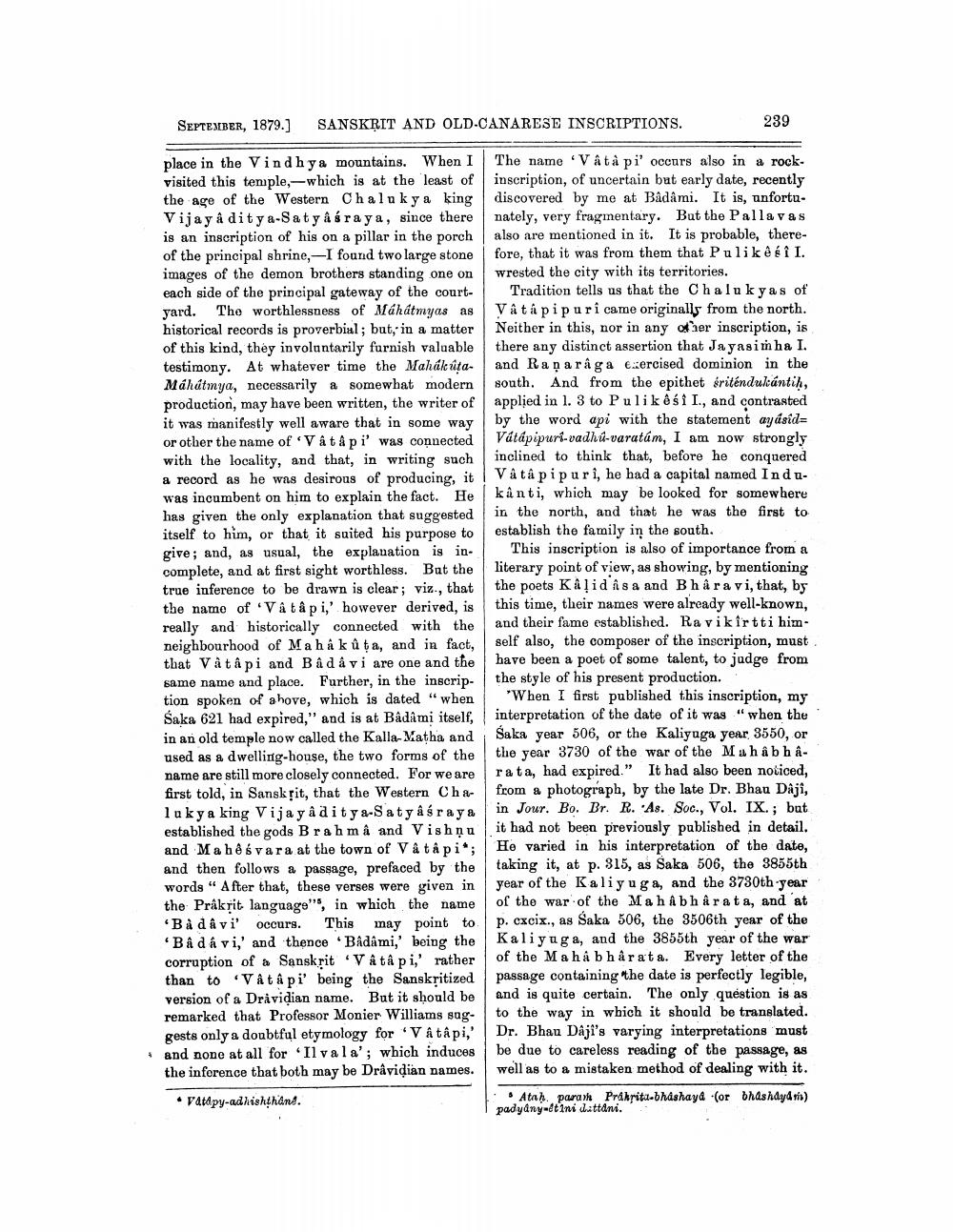________________
SEPTEMBER, 1879.]
SANSKRIT AND OLD-CANARESE INSCRIPTIONS
239
place in the Vindhya mountains. When I The name "Vâtà pi' occurs also in a rockvisited this temple, which is at the least of inscription, of uncertain but early date, recently the age of the Western Chaluky a king discovered by me at Badami. It is, unfortuVijay aditya-Satyasraya, since there nately, very fragmentary. But the Palla vas is an inscription of his on a pillar in the porch also are mentioned in it. It is probable, thereof the principal shrine,- I found two large stone fore, that it was from them that Pulike si I. images of the demon brothers standing one on wrested the city with its territories. each side of the principal gateway of the court- Tradition tells us that the Chalu kyas of yard. The worthlessness of Mahatmyas as Vå tapipuri came originally from the north. historical records is proverbiul; but," in a matter Neither in this, nor in any of her inscription, is of this kind, they involuntarily furnish valuable there any distinct assertion that Jayasimha I. testimony. At whatever time the Mahák úta- and Raņa râga exercised dominion in the Máhútmya, necessarily a somewhat modern south. And from the epithet sriténdulántik, production, may have been written, the writer of applied in l. 3 to Puli kêś i I., and contrasted it was manifestly well aware that in some way by the word api with the statement aydsid= or other the name of 'V åt & pi' was connected Vátapipuri-vadhu varatám, I am now strongly with the locality, and that, in writing such inclined to think that, before he conquered a record as he was desirous of producing, it Vatapipuri, he had a capital named Induwas incumbent on him to explain the fact. He kânti, which may be looked for somewhere has given the only explanation that suggested in the north, and that he was the first to itself to him, or that it suited his purpose to establish the family in the south. give; and, as usual, the explanation is in. This inscription is also of importance from a complete, and at first sight worthless. But the literary point of view, as showing, by mentioning true inference to be drawn is clear; viz., that the poets Kaļid îs a and Bhåravi, that, by the name of Vât âpi,' however derived, is this time, their names were already well-known, really and historically connected with the and their fame established. Ravikir tti himneighbourhood of Ma há k û ta, and in fact, self also, the composer of the inscription, must that Và tâpi and Bad à vi are one and the have been a poet of some talent, to judge from same name and place. Further, in the inscrip- the style of his present production. tion spoken of ahove, which is dated " when "When I first published this inscription, my Saka 621 had expired," and is at Badami itself, interpretation of the date of it was "when the in an old temple now called the Kalla-Matha and Saka year 506, or the Kaliyuga year 3550, or used as a dwelling-house, the two forms of the the year 3730 of the war of the Mahabhaname are still more closely connected. For we are rata, had expired." It had also been noticed, first told, in Sanskrit, that the Western Cha- from a photograph, by the late Dr. Bhau Daji, luky a king Vijay aditya-Satyasraya in Jour. Bo. Br. R. As. Soc., Vol. IX.; bat established the gods Brahma and Vishņu it had not been previously published in detail. and Maheśvara at the town of V å tå pi; He varied in his interpretation of the date, and then follows a passage, prefaced by the taking it, at p. 315, as Saka 506, the 3855th words“ After that, these verses were given in year of the Kaliyuga, and the 3730th-year the Prakrit language", in which the name of the war of the Mahabharata, and at Bå då vi' occurs. This may point top. cxcix., as Saka 506, the 3506th year of the Bå dá vi,' and thence Bâdami,' being the Kaliyuga, and the 3855th year of the war corruption of a Sanskrit V â tâpi,' rather of the Mahabharata. Every letter of the than to Vât å pi' being the Sanskritized passage containing the date is perfectly legible, version of a Dravidian name. But it should be and is quite certain. The only question is as remarked that Professor Monier Williams sag- to the way in which it should be translated. gests only a doubtful etymology for V Atâpi, Dr. Bhau Daji's varying interpretations must and none at all for 'Il vala'; which induces be due to careless reading of the passage, as the inforence that both may be Dravidian names. well as to a mistaken method of dealing with it. • vatdpy-adhishthans.
Ath. parave Prekrita-bhashayd (or bhashdydis) padyanyetini dattani.




